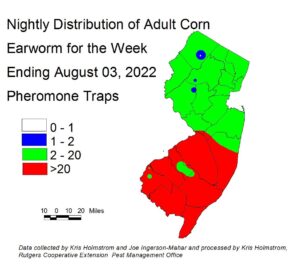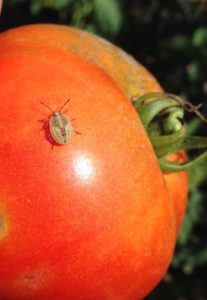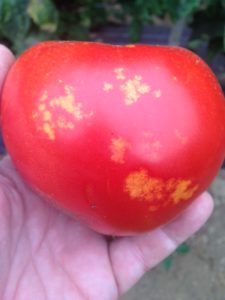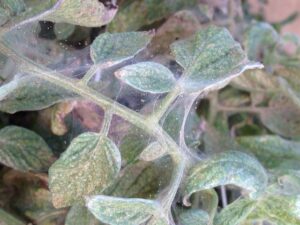Sweet Corn
European corn borer (ECB) moth catches are increasing slightly in parts of the state. Overall numbers remain quite low, however. ECB population maps will resume if second flight catches rise to high enough numbers.
The highest nightly trap catches of ECB for the week ending 08/03/22 are as follows:
| Centerton 1 | Farmingdale 1 | New Egypt 1 |
| Cinnaminson 1 | Georgetown 1 | Old Bridge 1 |
| Crosswicks 1 | Matawan 1 | Sergeantsville 1 |
| Downer 1 | Medford 1 | Springdale 1 |
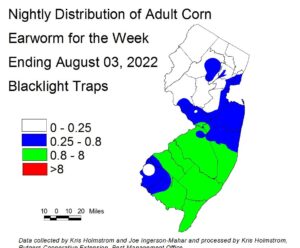 Corn earworm (CEW) moth captures from blacklight traps have increased further, and pheromone trap captures have increased to a larger degree in a number of south and central New Jersey traps. The highest catches are generally from Burlington County southward. Continued hot weather, with elevated nighttime temperatures will likely keep activity high. CEW populations can increase dramatically any time from now through the end of the season, depending on weather patterns. Growers should be on alert for large CEW migrations should NJ experience strong low pressure fronts approaching from the west. Check this publication weekly for CEW status. The number of pheromone traps deployed is much lower, resulting in much broader color bands on the map. It is also important to understand that pheromone traps are more sensitive than blacklight traps, and thresholds are adjusted to account for the higher catches typical of this trap type. Silking corn is at risk of CEW infestation at this time. On the blacklight map (left), green areas represent a 3-4 day silk spray schedule and blue represents a 4-5 day schedule. On the pheromone map (below right), red represents a 3 day spray schedule, green represents a 4-5 day schedule, and blue represents a 5-6 day schedule. Be sure to access information from this publication in the upcoming weeks to determine how frequently you should treat silking sweet corn to protect it from CEW infestation.
Corn earworm (CEW) moth captures from blacklight traps have increased further, and pheromone trap captures have increased to a larger degree in a number of south and central New Jersey traps. The highest catches are generally from Burlington County southward. Continued hot weather, with elevated nighttime temperatures will likely keep activity high. CEW populations can increase dramatically any time from now through the end of the season, depending on weather patterns. Growers should be on alert for large CEW migrations should NJ experience strong low pressure fronts approaching from the west. Check this publication weekly for CEW status. The number of pheromone traps deployed is much lower, resulting in much broader color bands on the map. It is also important to understand that pheromone traps are more sensitive than blacklight traps, and thresholds are adjusted to account for the higher catches typical of this trap type. Silking corn is at risk of CEW infestation at this time. On the blacklight map (left), green areas represent a 3-4 day silk spray schedule and blue represents a 4-5 day schedule. On the pheromone map (below right), red represents a 3 day spray schedule, green represents a 4-5 day schedule, and blue represents a 5-6 day schedule. Be sure to access information from this publication in the upcoming weeks to determine how frequently you should treat silking sweet corn to protect it from CEW infestation.
The highest nightly blacklight trap catches of CEW for the week ending 08/03/22 are as follows:
| Crosswicks 3 | Allentown 1 | Jones Island 1 |
| Folsom 3 | Cinnaminson 1 | Medford 1 |
| Elm 2 | Denville 1 | Sergeantsville 1 |
| Springdale 2 | Farmingdale 1 | Tabernacle 1 |
The highest nightly pheromone trap catches of CEW for the week ending 08/03/22 are as follows:
| Jones Island 129 | Georgetown 30 | Pedricktown 19 |
| Tabernacle 83 | Green Creek 30 | Woodstown 17 |
| Beckett 70 | Monroeville 30 | Matawan 13 |
| Folsom 45 | East Vineland 23 | Allamuchy 9 |
Silking Spray Schedules*:
South – 3 days
Central – 3-4 days
North – 4-5 days
*These recommendations are based on regional catches. Adhere to tighter spray schedules if indicated by local trap catches. Synthetic pyrethroids alone should NOT be used for corn earworm (CEW) protection on silking corn, or for fall armyworm (FAW) management at any stage. Control with these materials is very inconsistent. Utilize materials in IRAC groups 5 and 28, or combination products that include IRAC group 28 for best control. See the Sweet Corn section of the 2020-21 Commercial Vegetable Production Guide for selections.
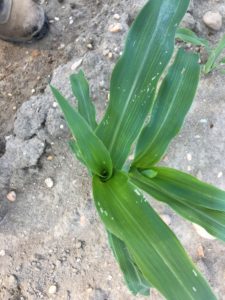
 Fall armyworm (FAW) larval infestations have remained steady at fairly low levels in southern and central counties, with injury occasionally reaching double digits as reported by field scouts. Cape May county continues to experience higher levels of infestation. This is the time of the summer when FAW can increase, resulting in significant injury to whorl and even seedling stage corn. Injury from newly hatched larvae shows up as “window panes” or areas where leaf tissue has been eaten down the the lower epidermis (see photo at far left). This injury leads down into the whorl. As larvae gain size, they begin to consume leaf tissue in its’ entirety, creating ragged holes and lots of droppings (see photo at near left). FAW can be tough to manage because it is resistant to synthetic pyrethroid insecticides (IRAC 3A) and because larvae are often covered by their own droppings, making contact with the insecticide more difficult. Treat when 12% or more plants exhibit FAW injury alone, or in combination with ECB injury. As a rule, insecticides that are most effective on CEW will also adequately control FAW.
Fall armyworm (FAW) larval infestations have remained steady at fairly low levels in southern and central counties, with injury occasionally reaching double digits as reported by field scouts. Cape May county continues to experience higher levels of infestation. This is the time of the summer when FAW can increase, resulting in significant injury to whorl and even seedling stage corn. Injury from newly hatched larvae shows up as “window panes” or areas where leaf tissue has been eaten down the the lower epidermis (see photo at far left). This injury leads down into the whorl. As larvae gain size, they begin to consume leaf tissue in its’ entirety, creating ragged holes and lots of droppings (see photo at near left). FAW can be tough to manage because it is resistant to synthetic pyrethroid insecticides (IRAC 3A) and because larvae are often covered by their own droppings, making contact with the insecticide more difficult. Treat when 12% or more plants exhibit FAW injury alone, or in combination with ECB injury. As a rule, insecticides that are most effective on CEW will also adequately control FAW.
With very hot temperatures, growers should be alert to the threat of sap beetle infestations in sweet corn. The ear tips of some corn varieties may grow through the husk under these conditions, allowing access to the kernels even without worm or bird injury. While the carbamate insecticide Lannate can provide control of this pest, growers may opt to include the neonicotinoid acetamiprid (Assail or Anarchy) with early silk sprays of less toxic materials. This material should limit sap beet increase in the plantings.
Black Cutworm
The adult moths have been flying now for the past two weeks based upon blacklight trap catches. There is no threshold for these moths and usually, only one or two moths are trapped at a time. Unfortunately, August is when feeding damage occurs on potatoes and sweet potatoes in the soil and on the stalks of late, whorl stage sweet corn. There is no good way to protect potatoes in the soil but sprays can be applied to sweet corn. Look for withered corn stalks of young whorl corn. The cutworms will feed just under the soil surface on the corn stalk and continue feeding upwards inside of the stalk. There is no exact threshold for this type of damage but if 6% or more of the stalks are killed then an insecticide application of carbaryl or a pyrethroid should be considered.
Tomatoes
Brown stink bug injury continues to be a common occurrence in tomato fields. These true bugs (see photo of Euschistus sp. nymph below at left), move into irrigated tomato fields as forage in the surrounding environment dries out. Feeding results in “cloudy spot” (see photo at right below). Increases in stink bug injury are often found by crews picking the fruit. Growers should consider 1-2 insecticide applications to limit fruit injury if this damage is increasing in harvested fruit. If actively scouting fields, insecticides should be considered if stink bug adults, nymphs or new fruit injury is found in 2 or more sample sites in a 10 site sample. Insecticides that are effective on stink bugs include pyrethroids and neonicotinoids (see Tomato Section from the 2022-23 Guide), so care should be taken to avoid contact with foraging bees.
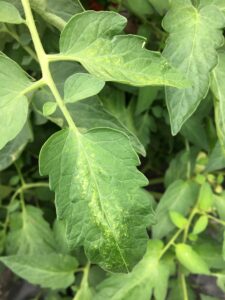 Two-spotted spider mites (TSSM) will remain a threat in nearly every scouted tomato field with hot, dry weather. Initial, low-level infestations result in a mite “stipple” on the upper leaf surface (see photo at right). In these cases several mites may be found on the lower leaf surface. With current conditions and no control applied, mites multiply rapidly. A large population will create webbing that can cover entire plant leaves and branches (see photo below). Large populations can become quite difficult to manage, so treatment should be applied upon finding a mite infestation at any level. This can limit future problems with this pest. There are a number of effective miticides listed in the Tomato Section from the 2022-23 Guide.
Two-spotted spider mites (TSSM) will remain a threat in nearly every scouted tomato field with hot, dry weather. Initial, low-level infestations result in a mite “stipple” on the upper leaf surface (see photo at right). In these cases several mites may be found on the lower leaf surface. With current conditions and no control applied, mites multiply rapidly. A large population will create webbing that can cover entire plant leaves and branches (see photo below). Large populations can become quite difficult to manage, so treatment should be applied upon finding a mite infestation at any level. This can limit future problems with this pest. There are a number of effective miticides listed in the Tomato Section from the 2022-23 Guide.
Peppers
Very low numbers of weevils are being caught at two farms in the Vineland area. There are no other reports of infested fields or weevils being trapped in other locations. Pepper growers in the Vineland area should be vigilant, looking for the yellowing stem of smaller fruit or fruit aborted from the plants. Cutting open these fruits may yield small whitish grubs which would be the weevil.
The best control rotations include Vydate, a neonicotinoid (Actara, Admire, Assail, others), a diamide (Exirel, Harvanta), and possibly Torac. University of Georgia researchers have found that all populations of pepper weevil that they have tested are resistant to pyrethroids. Since we don’t know where the weevils come from that we find here in New Jersey, farmers probably shouldn’t rely on pyrethroids being effective. Refer to the Rutgers Fact Sheet, FS1330: Monitoring and Management of Pepper Weevil in New Jersey (Rutgers NJAES) for more details on monitoring pepper weevil populations.
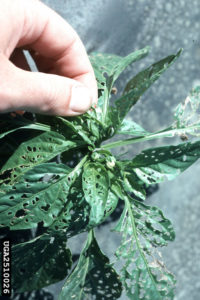 Beet armyworm adults (BAW) continue to be captured (13/night) in a pheromone trap near Woodstown over the past week. Jones Island (8/night) and East Vineland (3/night) have also recorded catches. Growers in Gloucester, Salem and Cumberland counties should monitor pepper fields weekly for signs of feeding. BAW larvae feed in the developing foliage in terminal growth of plants. Initially, leaves are skeletonized (photo at left, courtesy of Univ. of Ga.), but as larvae grow, they will move onto fruit and damage these as well. As with other armyworms, BAW is difficult to control with pyrethroid insecticides. Effective materials include spinosyns (IRAC 5) and diamides (IRAC 28).
Beet armyworm adults (BAW) continue to be captured (13/night) in a pheromone trap near Woodstown over the past week. Jones Island (8/night) and East Vineland (3/night) have also recorded catches. Growers in Gloucester, Salem and Cumberland counties should monitor pepper fields weekly for signs of feeding. BAW larvae feed in the developing foliage in terminal growth of plants. Initially, leaves are skeletonized (photo at left, courtesy of Univ. of Ga.), but as larvae grow, they will move onto fruit and damage these as well. As with other armyworms, BAW is difficult to control with pyrethroid insecticides. Effective materials include spinosyns (IRAC 5) and diamides (IRAC 28).
Pumpkins and Winter Squash
Cucurbit downy mildew (CDM) is active on cucumbers in all parts of the state. As yet, other cucurbits, including pumpkins, butternut squash, acorn squash and watermelons are NOT affected. As of Tuesday 8/2, the CDM forecast was for slight risk of new infection in northern NJ. For regional information on this important disease, see the Cucurbit Downy Mildew Forecast webpage: http://cdm.ipmpipe.org/. It is advisable that all growers treat preventively for CDM on cucumbers and muskmelons.
Cole Crops
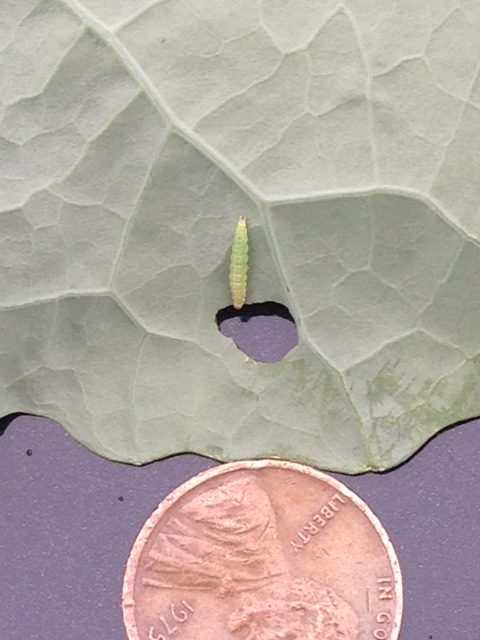 Host availability and elevated temperatures have made diamondback moth larvae ((DBM) see photo at right) the dominant caterpillar pest in many cole crop plantings. This pest can multiply quickly, with a generation completed in under 2 weeks with high temperatures. Furthermore, it is apparent that this pest is not responding to chlorantraniliprole (Coragen) in many parts of the state. Effective materials continue to be IRAC 5 materials (spinosyns), other IRAC 28 products like Exirel, and the IRAC 6 material, ememectin benzoate (Proclaim). Be sure to check the Cole Crops Section of the 2022-23 Commercial Guide for specifics, as PHI’s and crop labels vary. It is important to return to treated fields within 2-3 days to assess the efficacy of the insecticide applications. Effective materials should eliminate DBM larvae within 48 hours.
Host availability and elevated temperatures have made diamondback moth larvae ((DBM) see photo at right) the dominant caterpillar pest in many cole crop plantings. This pest can multiply quickly, with a generation completed in under 2 weeks with high temperatures. Furthermore, it is apparent that this pest is not responding to chlorantraniliprole (Coragen) in many parts of the state. Effective materials continue to be IRAC 5 materials (spinosyns), other IRAC 28 products like Exirel, and the IRAC 6 material, ememectin benzoate (Proclaim). Be sure to check the Cole Crops Section of the 2022-23 Commercial Guide for specifics, as PHI’s and crop labels vary. It is important to return to treated fields within 2-3 days to assess the efficacy of the insecticide applications. Effective materials should eliminate DBM larvae within 48 hours.
Brown Marmorated Stink Bug (BMSB)
BMSB numbers have moderated significantly over the past week. BMSB has not been a major pest of vegetable crops in NJ for a number of years, but is still of concern to tree fruit crops.
The highest nightly blacklight catches of BMSB for the week ending 08/03/22 are as follows:
| Crosswicks 17 | Downer 7 | Denville 3 |
| Centerton 9 | New Egypt 6 | Georgetown 3 |
| Allentown 8 | Farmingdale 4 | Old Bridge 3 |
| Green Creek 8 | Medford 4 | Princeton 3 |
Kristian Holmstrom and Joseph Ingerson-Mahar would like to gratefully acknowledge the efforts of field technicians:
Claire Chapeau
Travis Kaye
Gabe Torres
Without the hard work of our field technicians, much of the information presented weekly in the IPM Update would be unobtainable.
